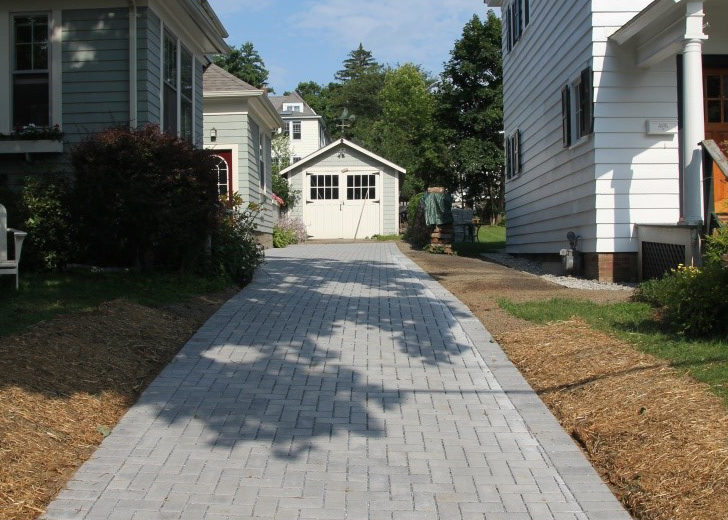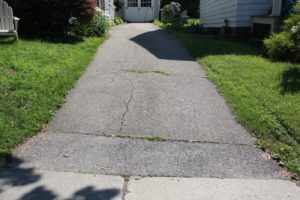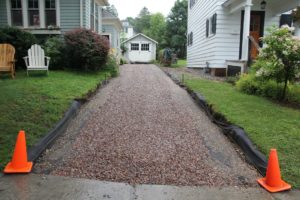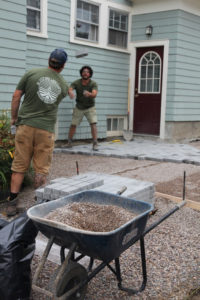Permeable Driveways and Lake Water Quality

By: Don Meals and Mary Sullivan
Asphalt, concrete, and even gravel driveways can be a big part of the impervious urban landscape. In our case, our cracked and heaved asphalt driveway represented 38% of the total impervious cover of our 7,000 ft2 lot in Burlington’s south end. Worse, the driveway sloped straight down to the street, where stormwater runoff collected and ran into the combined sewer system. It’s well known that impervious surfaces contribute stormwater and pollutants like sediment and phosphorus to the urban drainage system and often to Lake Champlain. Reducing the extent of impervious surfaces and infiltrating some of that stormwater into the ground is an important measure the city and individuals can take to reduce the impacts of stormwater runoff on water quality.

So when the time came to do something about our driveway, rather than simply repave it, we considered options for making it pervious – allowing the stormwater that previously ran off to infiltrate into the ground. We investigated paved strips surrounded by grass (sometimes called a “Hollywood driveway”) and various types of permeable pavement. We settled on converting about 100 ft2 directly in front of the garage back to grass – we store too many boats, bikes, and garden equipment to fit a car inside anyway – combined with installing a system of pervious concrete pavers on the rest of the former asphalt. We sought bids from several local landscaping companies that had experience in such installations. Finally, in July, 2017, we hired di Stefano Landscaping of Jericho, VT as our contractor and work began immediately.

The first step was to strip and remove the existing asphalt, then excavate about 2 feet down to form a giant bathtub. We were glad to find that the underlying soil was quite sandy and lucky that the excavator only encountered two immovable boulders that did not obstruct the project. The next step was to line the bathtub with filter fabric to separate the soil from the crushed stone to be added; the fabric holds back fine particles but readily passes water. Then the tub was filled with 18 inches of coarse crushed stone, which was compacted and carefully leveled to a proper elevation. Next, the individual pavers were placed by hand. Finally, a finer crushed stone was brushed into the ¼ inch gaps between the pavers. The last step was to add topsoil to the restored turf area and seed and mulch the exposed soil. The job was done by two men with a small excavator and a skid-steer and took about nine working days.

Ironically, within an hour of completion, we had a major downpour. I was out with an umbrella to observe our new driveway’s performance. It was easy to see that stormwater was no longer running down our driveway into the street; in fact, rain runoff did not make it from one 4×8 inch paver to the next. In contrast, runoff from a neighboring driveway was intensely flowing in a sheet across the sidewalk and into the street. This behavior has been repeated during the many storm events we have experienced this wet summer.
There is no doubt that our new driveway was expensive, costing perhaps three to four times as much as repaving with asphalt. We recognize too that it will require a bit more maintenance than plain asphalt to keep the spaces between pavers from becoming blocked with sediment or vegetation. We look at it as a contribution toward improving water quality in the Lake. Some of the pain was lessened by our participation in the Blue program, administered by LCI, International in cooperation with the City of Burlington and the Lake Champlain Basin Program. This program promotes adoption of residential green stormwater practices and offers some cost-share incentive to homeowners. We were fortunate to be the first property in Burlington to receive Blue certification. (BLUE Certification Program Lake Champlain International)
We are very happy with our end product. In addition to the stormwater benefits, we love the look of the pavers and have received many compliments from neighbors and passers-by. The new look has started frequent conversations about impervious cover, and we hope that it will stimulate others to consider similar projects. For those considering such a project, we recommend:
- Start planning and getting bids well before the summer work season;
- Get advice from Burlington DPW and Blue program staff to set design criteria for your project and begin participation with the cost-share program;
- Provide these criteria to bidding contractors;
- Seek landscaping contractors who have experience and references in installation of pervious paver systems; and
- Allow time to follow the permit system, which differs somewhat from the requirements of a more typical building project.
